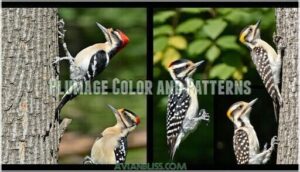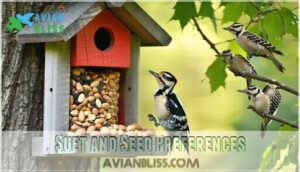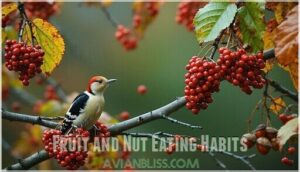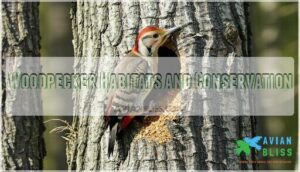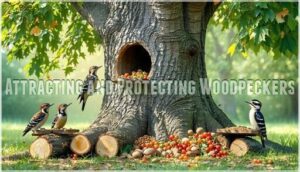This site is supported by our readers. We may earn a commission, at no cost to you, if you purchase through links.
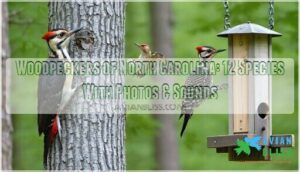
From the tiny Downy Woodpecker visiting your backyard feeders to the massive Pileated Woodpecker drumming deep in old-growth forests, each species brings unique behaviors and striking appearances.
Common year-round residents include Red-bellied and Hairy Woodpeckers, while Yellow-bellied Sapsuckers arrive seasonally.
The endangered Red-cockaded Woodpecker inhabits special longleaf pine ecosystems, and Northern Flickers break typical woodpecker rules by foraging on the ground.
These remarkable birds showcase everything from classic black-and-white patterns to unexpected brown plumage, each perfectly adapted to their preferred habitats and feeding strategies.
Table Of Contents
- Key Takeaways
- Woodpecker Species Overview
- Woodpecker Identification Tips
- Woodpecker Diets and Foraging
- Woodpecker Habitats and Conservation
- Attracting and Protecting Woodpeckers
- Frequently Asked Questions (FAQs)
- What is the most common woodpecker in North Carolina?
- What bird looks like a woodpecker but isn’t?
- What does it mean when woodpeckers pecking at your house?
- How can you tell a sapsucker from a woodpecker?
- Are there woodpeckers in North Carolina?
- Are there redheaded woodpeckers in North Carolina?
- What do woodpeckers eat in NC?
- What is the smallest woodpecker in North Carolina?
- What is the small black and white woodpecker in North Carolina?
- Are woodpeckers good to have in your yard?
- Conclusion
Key Takeaways
- You’ll find eight distinct woodpecker species throughout North Carolina’s 19.3 million forested acres, ranging from tiny 5.5-inch Downy Woodpeckers to massive 20-inch Pileated Woodpeckers
- Most species are year-round residents, but you can spot seasonal migrants like Yellow-bellied Sapsuckers during spring and fall, while the endangered Red-cockaded Woodpecker requires specialized longleaf pine habitats
- You can attract woodpeckers to your yard by offering suet feeders, sunflower seeds, and leaving dead trees standing, as these provide essential nesting sites and insect-rich foraging opportunities
- Each species has unique identification features—males typically sport red caps, Northern Flickers hunt ants on the ground instead of tree trunks, and their distinct calls and drumming patterns help you distinguish between species
Woodpecker Species Overview
You’ll discover an impressive diversity of woodpeckers throughout North Carolina, from tiny Downy Woodpeckers visiting backyard feeders to massive Pileated Woodpeckers creating rectangular holes in mature forests.
The state’s 19.3 million acres of forested habitat support eight distinct species, each with unique characteristics that make identification both challenging and rewarding.
Common Woodpeckers in NC
When exploring North Carolina woodpeckers, you’ll encounter five common species year-round.
Downy Behavior includes visiting backyard feeders, while Hairy Habitats span mature forests.
Flicker Diets focus on ground-dwelling ants, and Red-bellied ID features distinctive orange-red caps.
Pileated Nesting requires large dead trees.
These North Carolina woodpeckers offer excellent woodpecker identification opportunities for common woodpeckers NC enthusiasts studying woodpecker species throughout North Carolina.
Less Common Woodpeckers in NC
While you’ll spot the common species regularly, North Carolina’s less common woodpeckers require more patience to find.
Red-headed Woodpeckers face population decline due to habitat loss, making vagrant sightings exciting discoveries.
Red-cockaded Woodpeckers present identification challenges in their specific longleaf pine habitats.
Conservation efforts focus on protecting these vulnerable North Carolina woodpeckers from further decline.
Rare Woodpeckers in NC
North Carolina’s rarest woodpeckers face uncertain futures due to habitat destruction and conservation challenges.
The Red-cockaded Woodpecker stands as the state’s most endangered species, requiring immediate protection efforts. The woodpeckers exclusively nest in mature longleaf pines.
- Red-cockaded Woodpecker – Federally endangered species with only 18,000-19,000 individuals remaining
- Longleaf Pine forests – Critical habitat supporting these rare birds through specialized ecosystems
- Vagrant sightings – Extremely uncommon occurrences of non-resident woodpecker species
- Population decline – Ongoing threat from habitat loss and pine ecosystem destruction
- Conservation efforts – Active management programs protecting endangered species through habitat restoration
Woodpecker Migration Patterns
Most woodpeckers in North Carolina stay put year-round, but a few species follow predictable migration patterns.
Yellow-bellied Sapsuckers breed in mountain breeding grounds, then migrate to winter habitats in the Piedmont and Coastal Plain.
Red-headed Woodpeckers make seasonal movements from higher to lower elevations, while Northern Flickers use flyway routes for short-distance migrations triggered by food availability.
The Red-bellied Woodpecker is omnivorous and adaptable, thriving in various habitats and is known for being omnivorous.
Woodpecker Identification Tips
You’ll find woodpecker identification easier when you focus on key physical features and behaviors that distinguish each species.
Start by noting size differences, plumage patterns, and feeding habits to quickly narrow down your options in the field.
Plumage Color and Patterns
Looking at woodpecker species in North Carolina, you’ll notice striking plumage differences that make identification easier.
Red crest variation helps distinguish males from females—most male woodpeckers sport bright red patches while females don’t.
Belly coloration ranges from pure white in Downy Woodpeckers to the reddish wash of Red-bellied species.
Barred wing patterns create distinct zebra-like stripes, especially prominent in Red-bellied and Northern Flicker varieties.
Facial stripe differences separate similar species, while underwing markings reveal yellow flashes in flickers during flight.
Some species have striking black plumage, making them stand out.
Bird Behavior and Size
Beyond visual cues, you’ll notice distinct woodpecker behavior and size differences that make identification easier.
Size variation ranges dramatically—tiny Downy Woodpeckers at 5.5 inches contrast sharply with massive Pileated Woodpeckers reaching nearly 20 inches.
Watch their foraging behavior: Northern Flickers hunt ants on the ground while others prefer tree trunks.
Social interactions vary too, with Red-bellied Woodpeckers aggressively defending feeders.
Flight patterns also differ—some species show undulating flight while others fly more directly between trees.
Sound and Tail Characteristics
Listening to woodpecker calls and observing tail feather use helps you identify species quickly.
Each woodpecker has distinct vocalizations – sharp "peek" notes from Downy Woodpeckers versus loud "kuk-kuk" calls from Pileateds.
Drumming patterns vary too: rapid taps indicate smaller species, while slower, powerful beats suggest larger birds.
Notice how their stiff tail morphology acts like a kickstand, providing essential support during vertical climbing and feeding activities.
Beak Shape and Size
Examining beak characteristics reveals essential woodpecker identification tips for North Carolina species.
Beak morphology directly correlates with foraging efficiency – downy woodpeckers sport shorter, delicate bills for surface insects, while pileated woodpeckers wield powerful, chisel-like beaks for deep drilling.
Species variation reflects evolutionary adaptations: hairy woodpeckers possess longer bills than downies, and flickers show slightly curved beaks optimized for ground foraging, demonstrating how drilling power varies across woodpecker species.
Woodpecker Diets and Foraging
You’ll discover that North Carolina’s woodpeckers have surprisingly diverse diets, ranging from specialized ant hunters to aggressive feeder bullies.
Understanding their unique foraging strategies helps you appreciate why different species thrive in various habitats across the state.
Insect and Sap Consumption
You’ll find woodpecker diets fascinating as these birds have evolved specialized feeding strategies.
Most North Carolina species rely heavily on insect extraction using remarkable tongue mechanics that extend up to three times their bill length.
Here’s what drives their insect consumption:
- Ant Consumption – Northern Flickers specialize in ground foraging, often digging through dirt to reach ant colonies
- Beetle Larvae – Pileated and Hairy Woodpeckers target wood-boring beetle larvae deep within rotting wood
- Sap Specialization – Yellow-bellied Sapsuckers drill neat rows of holes to access tree sap and trapped insects
- Insect Extraction – Barbed tongues allow precise removal of termites, caterpillars, and other insects from tree cavities
- Seasonal Adaptation – Woodpecker feeding shifts between insects during breeding season and mixed diets year-round
These adaptations make woodpeckers incredibly efficient at controlling forest pest populations.
Suet and Seed Preferences
Most North Carolina woodpeckers can’t resist high-fat suet ingredients like rendered beef fat, nuts, and seeds.
You’ll find success offering black oil sunflower seeds, safflower seeds, and preferred nuts like peanuts at properly placed feeders.
Seasonal changes affect woodpecker feeding patterns, with suet becoming especially important during winter months when insects are scarce in North Carolina’s forests.
To attract more species, consider offering suet cakes to provide them with the necessary nutrients, making woodpecker feeding and suet cakes essential for their survival.
Fruit and Nut Eating Habits
North Carolina woodpeckers show distinct Preferred Fruits and seasonal eating patterns.
Red-headed woodpeckers cache acorns and beechnuts for winter Nut Storage, while red-bellied species favor berries and corn.
Seasonal Variation affects availability – summer brings abundant insects, but fall’s nuts become vital.
Their Orchard Impact can be significant when targeting fruit crops.
You’ll attract these birds to Backyard Feeders using mixed seeds and dried fruits, supporting their diverse woodpecker diet preferences throughout the year.
Foraging Techniques and Strategies
You’ll find woodpeckers use diverse foraging strategies to access their preferred food sources.
These bird feeding techniques showcase remarkable adaptability and specialization:
- Bark excavation and drilling – Species like Red-cockaded Woodpeckers target rotting wood for ant excavation, using their specialized beaks to access wood-boring insects beneath bark layers.
- Ground foraging patterns – Northern Flickers frequently hunt on forest floors, searching for ants and beetles through dirt and leaf litter.
- Aggressive defense strategies – Red-bellied Woodpeckers dominate feeding territories, while Red-cockaded species create resin barriers around nest sites for protection.
These woodpecker feeding strategies demonstrate how different species have evolved distinct approaches to maximize their woodpecker diet preferences and survival success.
Woodpecker Habitats and Conservation
Understanding where woodpeckers live helps you find and protect these fascinating birds in North Carolina‘s diverse landscapes.
From backyard forests to endangered pine ecosystems, each species has specific habitat needs that directly impact their survival and conservation status.
Year-Round Resident Habitats
You’ll find most North Carolina woodpeckers call the state home year-round, thriving in diverse Forest Composition from pine forests to hardwood stands.
These permanent residents have adapted to local Suburban Habitats and wooded neighborhoods where Nesting Trees and steady Food Availability support their needs.
Effective Habitat Management in woodpecker habitat NC guarantees these species maintain stable populations across their woodpecker range NC throughout all seasons.
Migratory Woodpecker Habitats
While some North Carolina woodpeckers migrate seasonally, most species are year-round residents with limited migratory movements.
Climate impacts and range expansion affect migration triggers, though woodpecker migration patterns remain less dramatic than other bird species.
Habitat connectivity supports these movements across the state’s diverse landscapes.
- Yellow-bellied Sapsuckers migrate through North Carolina during spring and fall, requiring stopover ecology sites
- Northern Flickers show partial migration, with some populations moving south while others remain resident
- Migration triggers include food availability, temperature changes, and breeding season timing
- Climate impacts are gradually shifting traditional woodpecker ranges northward in North Carolina
- Range expansion occurs when habitat connectivity allows species to establish new territories
Wooded Areas and Natural Habitats
Something magical happens when you explore North Carolina’s woodpecker species in North Carolina across diverse forest ecosystems.
Old-Growth Forests with abundant Snag Abundance provide ideal woodpecker habitats and ecosystems, while deciduous woods offer varied resources.
Forest Composition affects species diversity, though Habitat Fragmentation threatens connectivity.
Fire Ecology maintains healthy pine stands, supporting specialized species requiring mature forest structure for nesting and foraging success.
Conservation Status and Threats
Habitat loss devastates North Carolina’s woodpeckers, with longleaf pine forests reduced to just 3% of their historic range.
Fire suppression creates dense undergrowth that harms Red-cockaded Woodpeckers, while population decline affects multiple species.
Though endangered species protections and conservation efforts show promise, fragmentation and urbanization continue threatening these essential birds across their remaining habitats.
Attracting and Protecting Woodpeckers
You’ll find that creating the right environment makes all the difference in attracting these fascinating birds to your yard.
From choosing the proper feeders to leaving dead trees standing, simple changes can transform your space into a woodpecker haven while supporting their conservation.
Food Offerings and Feeders
Three strategic food offerings turn your yard into woodpecker paradise.
You’ll attract more species by providing diverse options through dedicated woodpecker feeders and backyard feeders that cater to their unique preferences.
- Sunflower seeds in sturdy bird feeders create irresistible dining spots
- Mixed seed varieties offer balanced nutrition for different woodpecker species
- Strategic feeder placement tips maximize visibility while ensuring safe access
Consider chewy seed options for the birds.
Suet Feeders and Seed Types
Quality suet ingredients like beef fat, peanut butter, and cornmeal attract woodpeckers year-round.
Choose specialized woodpecker feeders with tail props and cages as squirrel deterrents.
Offer sunflower seeds, nyjer, and mixed seed blends in backyard feeders.
Consider buying suet online for a wide selection.
During seasonal feeding periods, maintain fresh suet to prevent spoilage and guarantee consistent nutrition for visiting species.
Natural Areas and Dead Trees
Dead trees aren’t eyesores—they’re woodpecker gold mines! These "snags" provide essential nesting sites and insect buffets that North Carolina birds desperately need.
Forest management practices that preserve standing dead wood support habitat connectivity across the landscape. Conservation efforts now recognize snag importance, with fire regimes helping maintain natural woodpecker habitats.
Products for dead trees can help enhance these environments. Leave those dead branches standing—your feathered friends will thank you, as they rely on these snags for survival, making them a crucial part of the ecosystem’s natural woodpecker habitats.
Woodpecker-Friendly Yard Tips
Creating woodpecker-friendly spaces means combining native plants with smart landscaping choices.
Plant native berry bushes and nut trees that provide natural food sources throughout seasons.
Install shallow water sources like birdbaths for drinking and bathing.
Consider woodpecker nesting boxes for cavity-nesting species.
Limit pesticides to preserve insect populations that woodpeckers depend on for protein.
Leave some deadwood standing when safe – it’s prime real estate for foraging and nesting.
You can also attract them by offering suet cakes in wire cages.
Frequently Asked Questions (FAQs)
What is the most common woodpecker in North Carolina?
Like a well-oiled drumbeat echoing through Carolina’s forests, you’ll spot the Downy Woodpecker most frequently. This small, black-and-white resident thrives year-round in deciduous woods, backyards, and parks throughout the state.
What bird looks like a woodpecker but isn’t?
You’ll often mistake nuthatches for woodpeckers since they creep along tree trunks and probe bark crevices.
However, nuthatches move headfirst down trees, lack woodpeckers’ stiff tail feathers, and have shorter, thinner bills for different feeding behaviors.
What does it mean when woodpeckers pecking at your house?
Woodpeckers peck houses for three main reasons: they’re searching for insects hiding in wood siding, claiming territory by drumming loudly, or creating nest cavities in suitable wood surfaces.
How can you tell a sapsucker from a woodpecker?
Sapsuckers are actually a type of woodpecker. Yellow-bellied Sapsuckers drill neat rows of holes in trees to drink sap, while other woodpeckers excavate irregular cavities hunting for insects.
Are there woodpeckers in North Carolina?
Yes, North Carolina hosts eight woodpecker species as permanent residents or seasonal visitors. You’ll find common ones like Downy, Hairy, and Red-bellied woodpeckers throughout the state’s 3 million forested acres year-round.
Are there redheaded woodpeckers in North Carolina?
Red-headed woodpeckers are found throughout North Carolina as permanent residents. You can spot them with their distinctive solid red heads, black backs, and white chests in open woodlands and parks.
What do woodpeckers eat in NC?
Like busy carpenters at a buffet, North Carolina’s woodpeckers feast on insects like ants, beetles, termites, and larvae, plus berries, nuts, and acorns for balanced nutrition.
What is the smallest woodpecker in North Carolina?
The Downy Woodpecker is North Carolina’s smallest woodpecker species, measuring just 5 to 1 inches long. You’ll recognize males by their red cap and females by their all-black heads on compact bodies.
What is the small black and white woodpecker in North Carolina?
In North Carolina, you’ll find the Downy Woodpecker – a charming little bird with black and white striped patterns, white chest, and males sporting a distinctive red cap that’s hard to miss.
This single sentence provides a complete concept about the Downy Woodpecker.
Are woodpeckers good to have in your yard?
Welcoming these feathered friends brings natural pest control benefits to your space.
You’ll enjoy watching woodpeckers consume thousands of harmful insects like beetles, ants, and termites that damage trees and gardens, creating a healthier yard ecosystem.
Conclusion
Picture winter mornings when frost clings to bark and your breath forms clouds—that’s when woodpeckers of North Carolina become most noticeable, their sharp calls echoing through dormant forests.
You’ve now explored twelve remarkable species, from common backyard visitors to rare conservation treasures.
Understanding their unique behaviors, preferred habitats, and distinct calls helps you identify each woodpecker you encounter.
Whether you’re spotting a Red-bellied Woodpecker at your suet feeder or listening for a Pileated Woodpecker’s powerful drumming, these adaptable birds continue thriving across North Carolina’s diverse landscapes.
- https://avianreport.com/woodpeckers-kentucky-tennessee-north-carolina/
- https://www.ncwildlife.gov/species/red-cockaded-woodpecker
- https://wakeaudubon.org/conservation/boty/bird-of-the-year-2020/
- https://triangleland.org/blog/the-wondrous-woodpeckers-of-north-carolina
- https://www.audubon.org/field-guide/bird/red-headed-woodpecker

